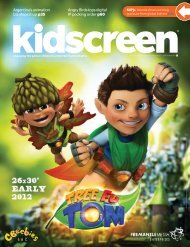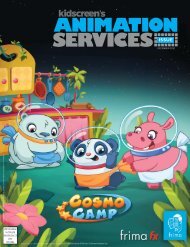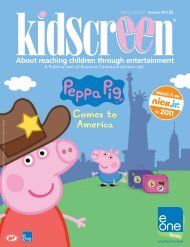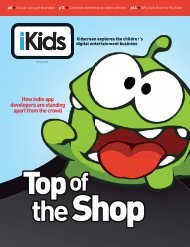download a PDF version - Kidscreen
download a PDF version - Kidscreen
download a PDF version - Kidscreen
You also want an ePaper? Increase the reach of your titles
YUMPU automatically turns print PDFs into web optimized ePapers that Google loves.
The method<br />
In February, we identified the 10 countries we felt would help<br />
form a representative cultural landscape of the planet. We<br />
based our choices on a range of criteria including economic<br />
indicators, perceived influence (regional, global, political,<br />
cultural and economical), geographical position, population<br />
size and projected economic and population growth.<br />
We then decided to focus on India, Brazil, China, Russia,<br />
Saudi Arabia, the UK and US, Nigeria, South Africa and<br />
Australia as our countries of interest.<br />
We recruited more than 10,000 parents of children<br />
ages two to 12 across these 10 very different countries and<br />
took great trouble to ensure that the subjects were broadly<br />
comparable in terms of socio-economic status across territories.<br />
Perhaps most importantly, we made sure that the<br />
respondents were all very outward-looking and media literate.<br />
We wanted opinion-makers and early adopters to help<br />
us understand what the future landscape of globalization is<br />
going to look like for families.<br />
The parents were then asked to consider just one of their<br />
children as they answered our 50 questions, and the results<br />
have been astonishing.<br />
Family consumption patterns and parents’ perspectives<br />
on education, the future, modern media, technology and<br />
the erosion of childhood were all investigated. We also asked<br />
parents about how they spend time as a family and the importance<br />
they place on this.<br />
Parents and culturally relevant content<br />
Beyond a wealth of insight around the aforementioned and<br />
other categories, the thing that has really hit home for us is<br />
that despite many similarities between global parents, the<br />
significance they place on offering their children culturally<br />
specific content varies wildly. It seems that some countries<br />
will effectively take what they’re given, while others are<br />
becoming ever-more demanding that high quality localized<br />
content is made available to their kids. These parents,<br />
it turns out, are increasingly<br />
holding the purse strings of the<br />
global family market.<br />
We tallied up the importance<br />
each country’s parents<br />
place on culturally relevant<br />
content (see chart opposite). In<br />
speaking to parents, it became<br />
clear that there is a growing<br />
fear that their children are increasingly<br />
exposed to foreign<br />
content that is shaping kids’<br />
perceptions and values—in<br />
many ways defining them as<br />
global children.<br />
The fact that parents in China<br />
and India—which together<br />
represent nearly half the world’s<br />
population—see the need for local<br />
content as very important,<br />
Importance of<br />
local content<br />
to parents<br />
Not important .<br />
As long as my child enjoys it then it does<br />
not really matter where it comes from.<br />
Quite important.<br />
I think it’s a good thing for them to get<br />
a balance of influences from our own<br />
culture and from others.<br />
Very important.<br />
I prefer them to access content from<br />
my own culture/country.<br />
and rank it significantly higher than the more developed western<br />
markets, is very telling. That these emerging titans wish to<br />
have content that’s relevant to them made readily available is<br />
not surprising at all, and maybe it shouldn’t be just the big studios<br />
that are listening.<br />
The majority of the parents, meanwhile, indicated local<br />
content was “quite important” and that maintaining a balance<br />
between their own and other cultures is a concern.<br />
South African, US, Australian and UK respondents, for<br />
their part, said it was not important, as long as their children<br />
enjoy the content, which is perhaps indicative of where these<br />
countries find themselves in the global cultural landscape.<br />
Beyond media, as we would expect from children ages<br />
seven to 12, the significant figures in their lives like parents<br />
and grandparents are very influential. Their heroes also<br />
tend to be drawn from their own culture, from family and<br />
friends to community leaders and people in the public eye.<br />
It’s also worth noting that the first generation of Digital<br />
Natives are now parents. They are buying more apps and<br />
are more open to the cultural influence of the global village<br />
than any other group, but the fact remains they also want<br />
their children to grow and understand what it is to be a citizen<br />
of their respective nations.<br />
Mobile, a cultural carrier<br />
The world is shrinking in terms of cultural influences because<br />
the global child continues to adopt digital media.<br />
And the leapfrogging of the messy business of cables in<br />
favor of wireless networks might just be the thing that<br />
catapults emerging nations forward. We all know mobile<br />
is king, and now the data bears this out…<br />
Digital TV ownership has followed trends in relatively<br />
under-developed markets such as African countries, where<br />
62% of the respondents overall own a digital TV, and as we<br />
would expect, the prevalence of laptop and tablet computers<br />
is very high. But the really interesting insights come when<br />
we look to mobile ownership—particularly in Africa.<br />
Global Child<br />
China<br />
Russia<br />
Saudi Arabia<br />
Brazil<br />
India<br />
Nigeria<br />
Sth Africa<br />
USA<br />
UK<br />
Australia<br />
12 % 14 % 10 % 26 % 15 % 24 % 11 % 5 % 9 % 5 % 7 %<br />
51 % 63 % 54 % 62 % 60 % 51 % 56 % 39 % 42 % 44 % 43 %<br />
37 % 23 % 36 % 12 % 25 % 25 % 33 % 56 % 49 % 51 % 50 %<br />
100%<br />
75%<br />
50%<br />
25%<br />
0%<br />
© Kids Industries 2013<br />
May/June 2013<br />
43
















